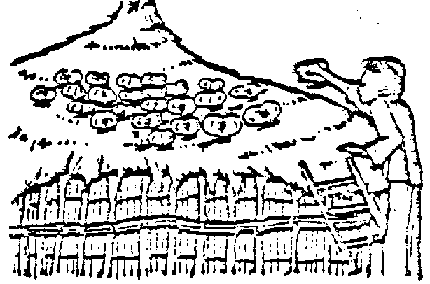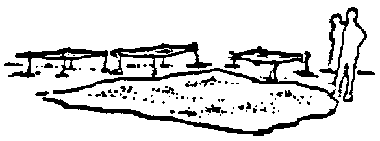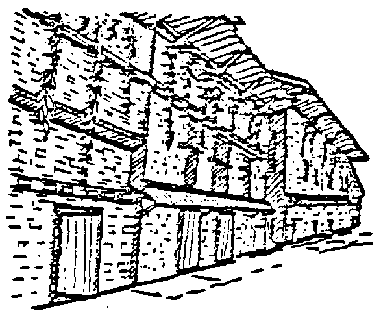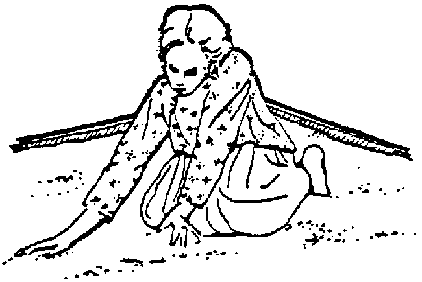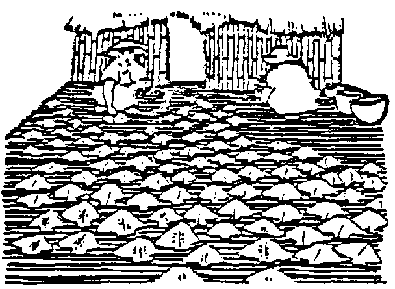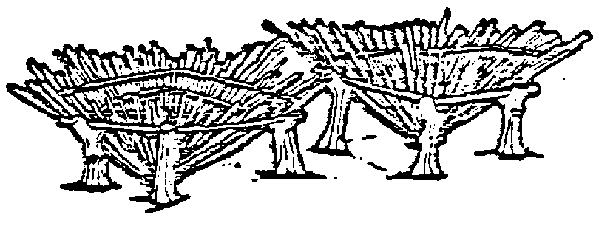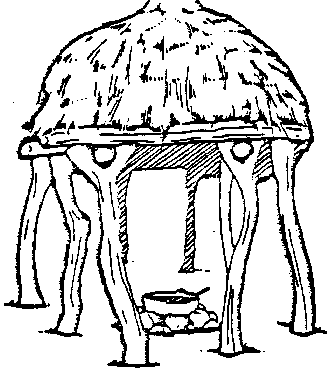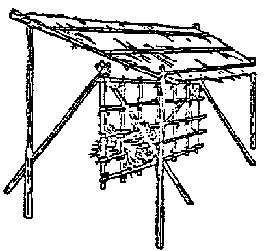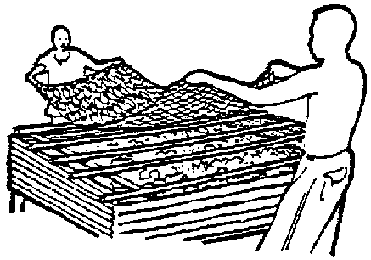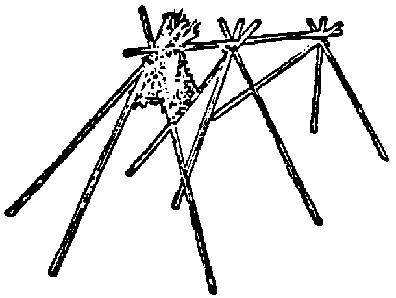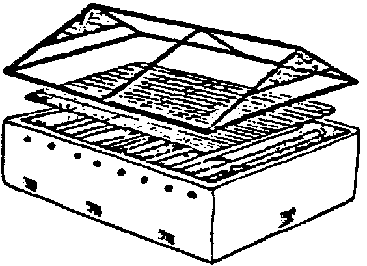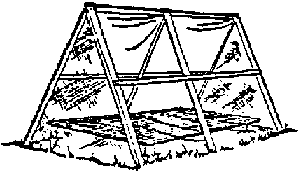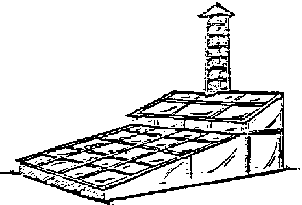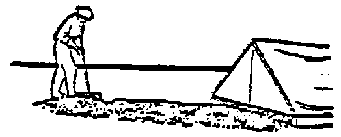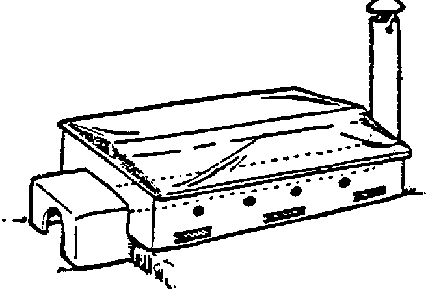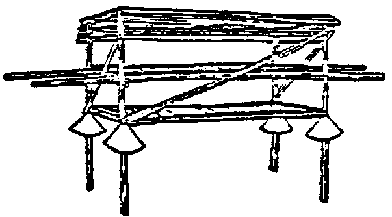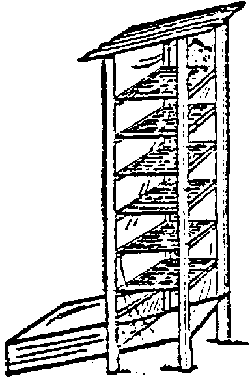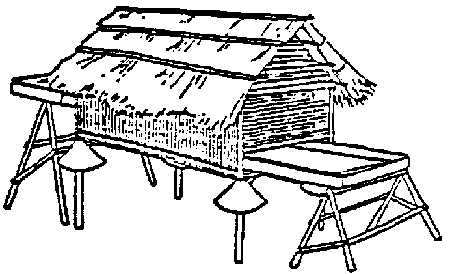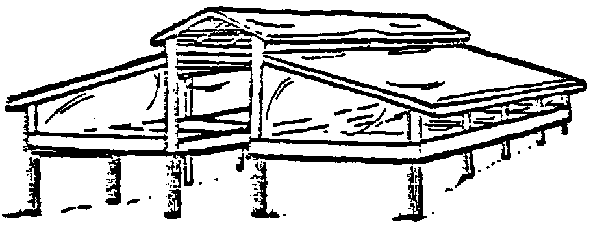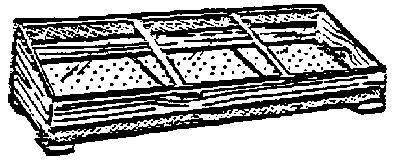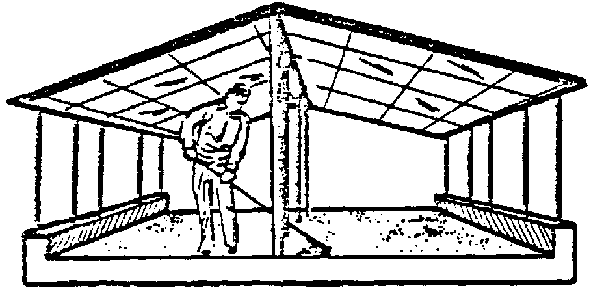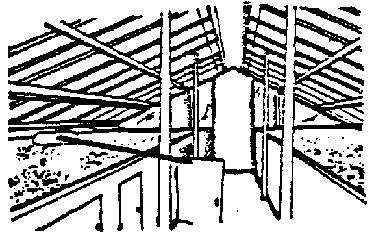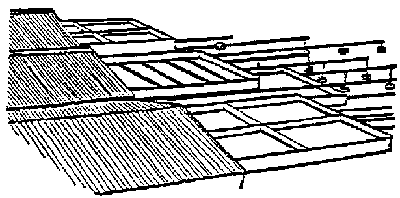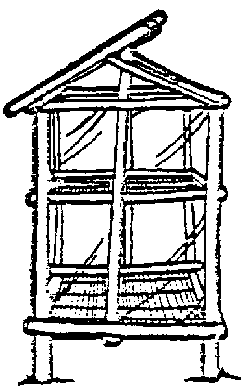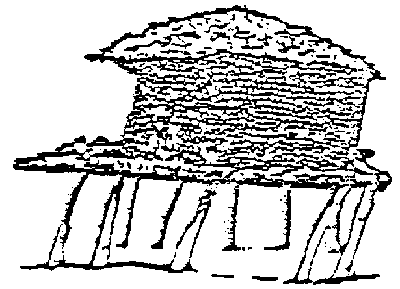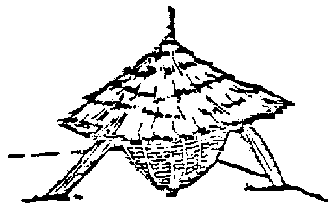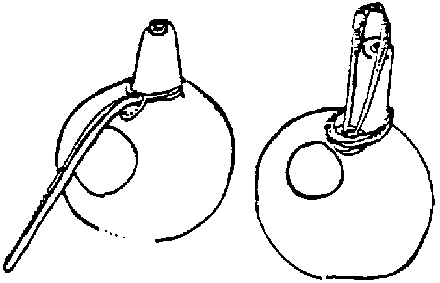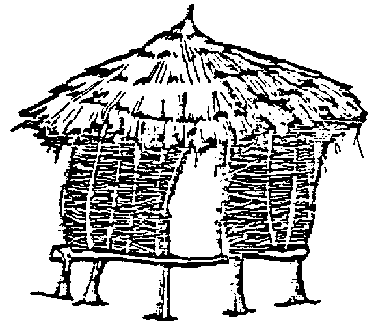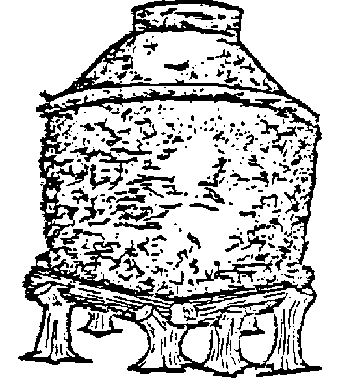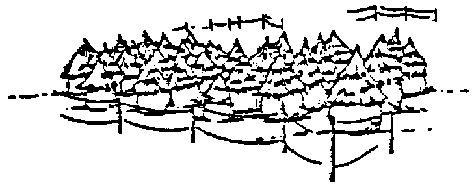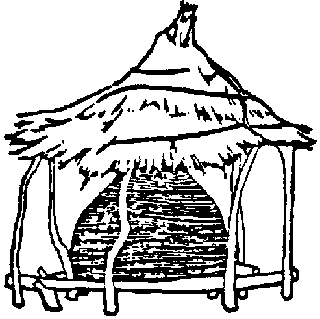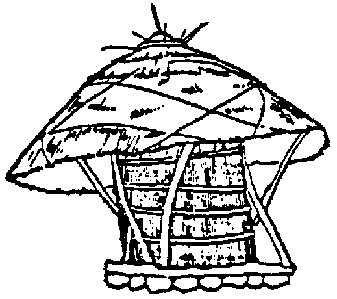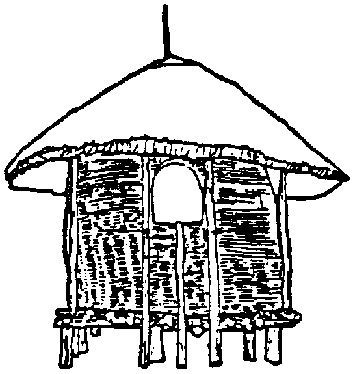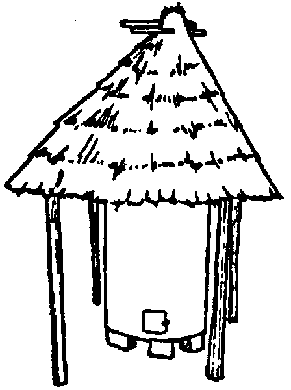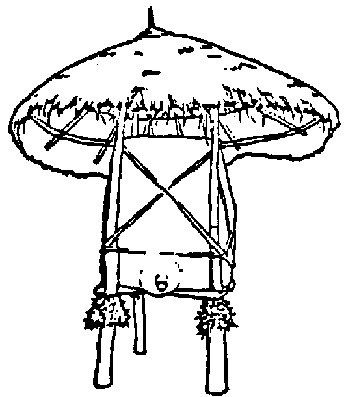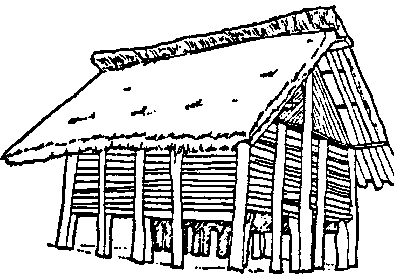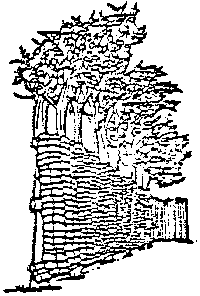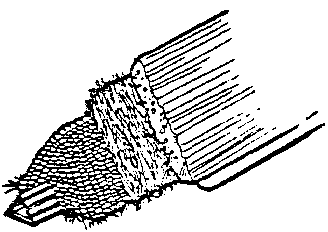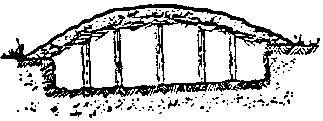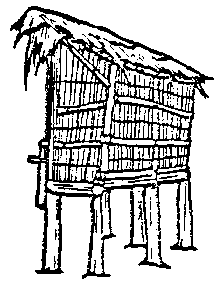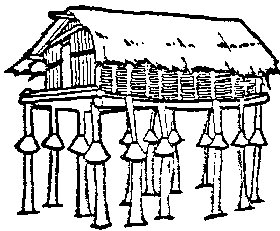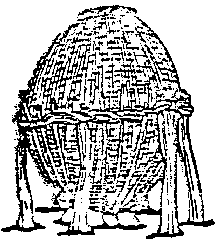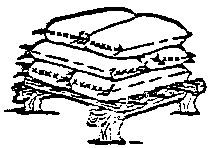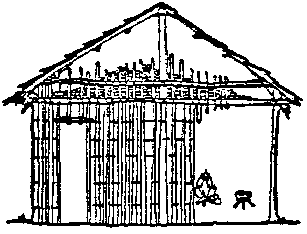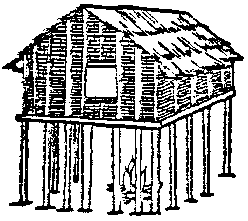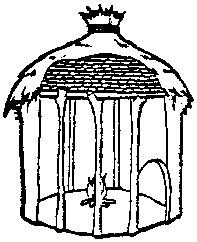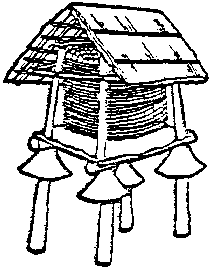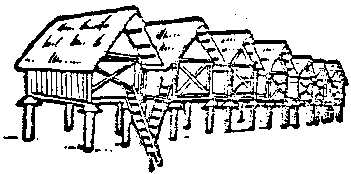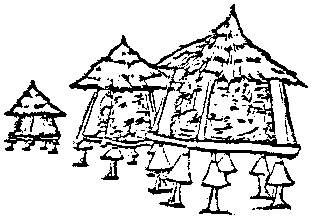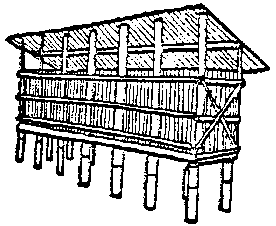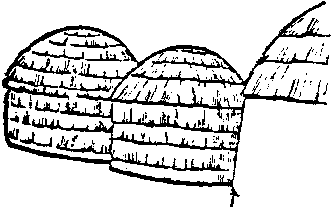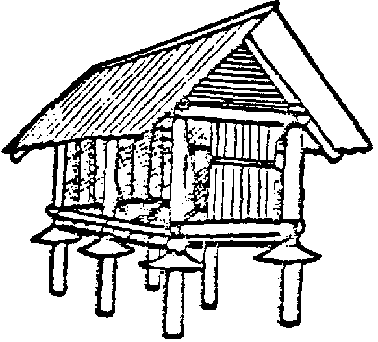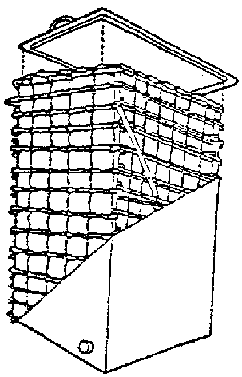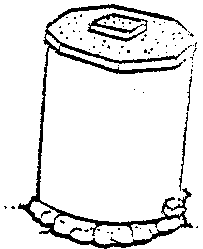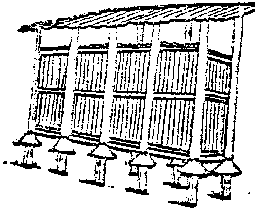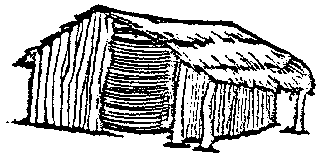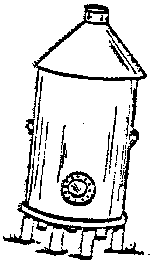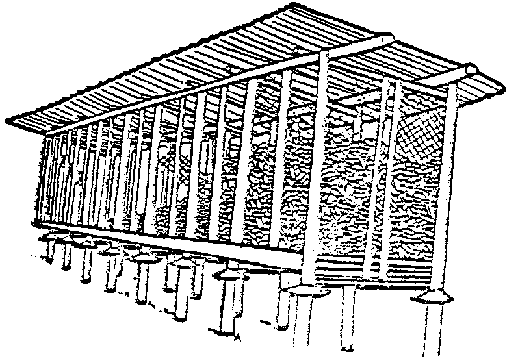
Solar and Energy Conserving Food Technologies
- (Peace Corps, 1984, 175 p.)
Model solar food dryer: design and construction
OVERVIEW AND GOALS:
Through the design and construction of cardboard model Solar Food Dryers (SFD's), participants will have the opportunity to utilize and experiment with the design criteria learned in Session 5 (Solar Food Dryers: Design Theory) before building their permanent dryer. The cardboard models will also enable them to begin using and experimenting with a dryer right away. In addition, each construction team will look at the dynamics of their group so that they can discover and use ways Of working on a task efficiently and cooperatively.
OBJECTIVES:
To design, construct and present a SFD model appropriate to a specific situation.
To examine the dynamics of a group and discover ways of promoting cooperation and efficiency.
RESOURCES:
"Brace Research Institute Dryer Survey"
"Preserving Food by Drying"
"Proceedings of Solar Dryer Workshop, Manila"
"Drying Foods in the Tropics"
"Small Farm Grain Storage"
HANDOUTS:
Solar Food Design Criteria, Handout 5A
Evaluation Checklist for Solar Food Dryers, Handout 6A
A Catalog of Dryers and Stores, Handout 6B
Survey of Group Behavior, Handout 6C
MATERIALS:
Cardboard boxes of varying sizes and shapes plastic screen
Netting
Bamboo and wood for tray frames
Black latex paint
Paint brushes
Tin snips
Saws, hammers
Large scissors, sharp knives
Thin wire
Clear plastic
Black plastic
Sheet metal
Tacks
Small nails
Adhesive tape
Wand glue
String
Tin cans
Staple guns, staples
Air thermometers
Incense and matches
PREPARATION:
Gather tools and materials, and arrange them so that they are easily accessible during the construction process.
Make sure there is adequate work space for each group.
Copy the "Evaluation Checklist for Solar Food Dryers" onto newsprint, and post.
PROCEDURES AND ACTIVITIES:
1. (20 minutes) Introduction
Review objectives.
Discuss the purpose of building the cardboard models.
Briefly review the "Evaluation Checklist for Solar Food Dryers". Ask for and record an newsprint any additional ideas from the group.
Remind participants to use the list as a guideline during the design, construction and presentation of the model dryers.
Indicate what tools and materials are available.
Stress the importance of experimenting with design innovations while still keeping the principles of Solar Food Dryer design in mind.
Inform the group that drawing plans of the dryer first is optional because of the time limitation, but that the plan needs to be well thought out and agreed on by all members of the team.
2. (3 hours; 30 minutes) Design and Construction
Facilitate the formation of work groups of 3-4 people (possibly by region).
Have each group
- decide on a real or hypothetical situation
- determine what their design criteria will be
- design and construct a SFD appropriate to their situation.
Remind participants that 'Solar Food Dryer Design Criteria", Handout 5A and "A Catalog of Dryers and Stores" Handout 6B may be helpful for gathering design ideas.
Circulate among the construction groups. When it appears that the design and construction phase of the activity is drawing to an end, distribute Handout 6C "Group Behavior Survey". Ask each group to spend a few minutes filling out the survey and discussing it.
3. (30 minutes) Presentations and Discussion
Reassemble the group, and have each team present their model dryer. They should describe:
- the design criteria used
- any innovations they tried
- problems encountered and how the group dealt with them
Encourage comments and questions from the group.
Ask a representative from each group to give a "profile" of their construction team, focusing on the dynamics that characterized the design and construction session.
Guide a general discussion about ways to improve the cooperation and efficiency in work teams.
TRAINER'S NOTE
Remember that the area of group dynamics may be a sensitive one, especially if there has been friction in the construction teams, or a tendency for "strong" personalities to take over. It is important to lead the discussion in a way that encourages communication, and that it is not threatening to group members
Encourage comments and questions from the group.
( 10 Min. ) Summary
Answer any further questions regarding the dryer design. Remind participants that they can either improve on this design or start a new one for the construction of permanent Solar Food Dryers later on.
EVALUATION CHECKLIST FOR SOLAR FOOD DRYERS
Use this as a guide during the Solar Food Dryer design sessions, and for continued evaluation and modification of your dryer throughout the course.
COMPARE TO THE LOCAL METHOD FOR
- Quality
- Simplicity
- Ease of use
- Cost
IS IT CULTURALLY ACCEPTABLE?
IS THE SIZE ADEQUATE FOR ITS PROJECTED USE?
WILL IT BE EASY TO MAINTAIN?
DOES IT USE LOW-COST AND LOCAL MATERIALS WHENEVER POSSIBLE?
DOES IT ACHIEVE THE DESIRED TEMPERATURE RANGE WITHOUT OVERHEATING?
DOES IT ALLOW FOR AN ADEQUATE RANGE OF VENT SIZE OPENINGS?
IS IT LIGHT ENOUGH TO BE EASILY MOVED IF THAT IS REQUIRED?
IS THE DRYER INSECT AND RODENT PROOF?
WILL IT STAND UP TO THE WEATHER IF LEFT OUTSIDE?
WHAT, IF ANY, DESIGN MODIFICATIONS WOULD YOU SUGGEST TO SIMPLIFY THE DRYER'S CONSTRUCTION OR USE?
Handout 6B
CATALOG OF DRYERS AND STORES
From Improved Drying and Storage Training Manual
Fig. 1 Traditional hut-roof fish drying, Zambia
Fig. 2 Traditional drying on ground and raised platforms, India
Fig. 3 Traditional vegetable trying under roof eaves, Nepal
Fig. 4 Traditional sun-drying of rice, Java
Fig. 5 Sun drying salted catfish, Cambodia
Fig. 6 Traditional foot fryers, Kenya
Fig. 7 Traditional dryer/storage in attic of cookhouse, Kenya
Fig. 8 Improved post-harvest air dryer for rice, Sierra Leo
Fig. 9 Fish smoker, Ivory Coast
Fig. 10 Improved post-harvest air dryer for rice, Sierra Leone
Fig. 12 Solar tent dryer, Philippine:
Fig. 12 Solar tent dryer, Philippine:
Fig. 13 International Rice Research Institute solar rice fryer, Thailand
Fig. 14 Concrete drying floor with foul weather cover, Columbia
Fig. 15 VITA solar dryer with fuel fired rainy season dryer attached
Fig. 16 Improved air dryer/store, Sierra Leone
Fig. 17 Solar "chimney" fryer with pre-heater
Fig. 18 Improved air-dryer for cocoa and coffee, Sierra Leone
Fig 19 Walk-through, plastic-covered, solar coffee fryer, Columbia
Fig. 20 Solar cabinet dryer, Syria
Fig. 21 Plastic-covered concrete drying floor for coffee, Columbia
Fig. 22 Plastic-covered, walk through solar coffee dryer, Columbia
Fig. 23 Pull-out, rolling carts for drying coffee, Columbia
Fig. 25 Traditional corn barn, Ghana
Fig. 26 Traditional Gottera, Ethiopia
Fig. 27 Traditional calabash seed stores, Kenya
Fig. 28 Improved dry-store hut, Benin
Fig. 29 Traditional muddied basket, Chad
Fig. 30 Traditional muddied stores, West Africa
Fig. 31 Traditional Kamba grain store, Kenya
Fig. 32 Traditional grain store, Kenya
Fig. 33 Traditional covered basket store, Kenya
Fig. 34 Improved Ghana grain silo
Fig. 35 Improved muddied basket with rat guards, Kenya
Fig. 36 Traditional Kipsigis grain store, Kenya
Fig. 37 In the field potato clamp
Fig. 38 Yams tied to poles and trees for drying and storage
Fig. 39 Improved potato clamp with air circulation tube
Fig. 40 Semi-subterranean potato storage house
Fig. 41 Improved maize crib built from local materials
Fig. 42 Dungu, improved with rat guards, Tanzania
Fig. 43 Traditional grain storage basket, Ivory Coast
Fig. 44 Improved grain sack storage inside warehouse
Fig. 45 Traditional attic storage, Tanzania
Fig. 46 Traditional Dungu, Tanzania
Fig. 47 Traditional grain drying and storage
Fig. 48 Traditional store improved with rat guards
Fig. 49 Traditional raised rice stores, Laos
Fig. 50 Traditional nkhokwe improved with rat guards and muddying, Malawi
Fig. 51 Improved maize crib built from local materials, Nigeria
Fig. 52 Hygenic rice store, China
Fig, 53 Improved crib built from imported materials, Swaziland
Fig, 53 Improved crib built from imported materials, Swaziland
Fig. 55 Air-tight brick silo, Tanzania
Fig. 56 Maize crib, improved with rat guards, Nigeria
Fig. 57 Metal grain tank with thatch roof, Swaziland
Fig. 58 Imported steel grain silo, Benin
Fig. 58 Imported steel grain silo, Benin
Descriptions of the Dryers and Scores
Fig. 1: In Zambia, fish are split in two and placed on hut roofs in the morning. They take one or two days to dry. Placing them on the roof keeps them away from animals, children and ground dust.
Fig. 2: Drying on tarps, mats, or plastic sheets can be found all around the world. Some areas will have specially made concrete drying floors. By raising the food off the ground, using platforms, air is allowed to pass up through the food and it dries somewhat faster.
Fig. 3: By hanging vegetables (mostly onions, garlic and peppers) under the eaves on south-facing walls, the Nepalese take advantage of the sun, avoid the rain and keep their foods away from the dirt, animals and people on the street.
Fig. 4: In Java, rice is threshed soon after harvest and spread on raised mats. The children are responsible for turning the rice so that it will dry faster.
Fig. 5: Cambodians salt their catfish (which draws some moisture out of the fish and also preserves it from bacterial infection) then split them open and spread them on decks to dry.
Fig. 6: Inverted cones, made from wooden sticks, catch a large percentage of the sun's light in Kenya because that country is on the equator. The food is placed on the inside of the cone to keep it away from animals and children.
Fig. 7: By placing foods (usually grains, maize) in the attic of a cookhouse, the heat from the smoke dries the food while the smoke repels insects. The food takes on a smoke smell and flavor, which is favored by some and disliked by others.
Fig. 8: This air-dryer will hold many "ties" of rice after it is harvested so that the rice does not have to be stacked up in the field where it can easily mold. The device is made from local "bush poles" and can be covered by a thatch roof to keep off rain during the wet-season harvest.
Fig. 9: The typical "banda" or Nest Africa uses a large amount of wood to smoke a small amount of fish (usually 6kg wood per 10kg fish). Smoking dries the fish, repels insects and adds flavor.
Fig. 10: A simpler model or Fig. 3. This can easily, be set up, taken down and the horizontal poles can be carried home, loaded with "ties" of rice.
Fig. 11: The standard VITA dryer has small inlet vents near the ground and virtually no high outlet vents. It can be improved by giving it larger inlet vents and large, screened vents at either end of the single-glazed roof.
Fig. 12: The Philippines solar tent dryer is low-cost and easy to build and operate. It can be improved by making all of both ends of the dryer screened. One of the plastic sides can be made with black plastic (especially for fish).
Fig. 13: The IRRI dryer can dry 400 kilograms of paddy in three or four days, depending on the weather conditions. The outlet chimney can be made larger to improve air flow. The plastic must be replaced as it wears out (about 1-3 times/year).
Fig. 14: Coffee (or other roods) can be stirred to maximize drying. At night and in case of rain, it can be pushed under the "tent" to minimize spoilage.
Fig. 15: Here the VITA dryer has been improved with a fuel-fired "stove" attached so the smoke - and heat - travels through the dryer, under the foods and exits through the stovepipe at the other end. The smoke does not flow through the food.
Fig. 16: This improved dryer/store has a removable roof that can be placed on the "handles" at either end to increase the drying tray area. The roof can be replaced at night or during rain and the rat-guards keep away the rats.
Fig. 17: This dryer has a fairly small solar collector/preheater for the number of trays inside, out the clear sides would act to collect solar energy also, thus improving performance. In a warm climate this dryer would work well.
Fig. 18: This dryer was made totally from local materials. The trays slide out during the day and slide under the roof cover at night and during rainy periods.
Fig. 19: This dryer makes an improvement over the raised platform by covering it with plastic. Air rises up through the slatted tray bottoms, the food is raked to improve drying and there is no need to worry about rain.
Fig. 20: a small, direct-gain solar dryer with low inlet vent in front and high outlet vent in back.
Fig. 21: A variation on Fig. 19. If this dryer becomes much more enclosed, some people will refuse to enter because of the high temperatures.
Fig. 22: An interior view of a dryer similar to Fig. 19. Note the stirring rake and the storage cupboards under the drying trays.
Fig. 23: These large trays roll out from under their cover in the morning and roll back at night and in case of rain. Several levels of trays allow a large quantity of food to be dried or stored at once.
Fig. 24: Simple design, easily made from local "bush poles", with mosquito netting trays and vents, surrounded with plastic. Stands about 1-1/2 meters high.
Fig. 25: Maize is stacked neatly around the perimeter, butt out, with the majority of the cobs randomly stacked inside. The roof is lifted to remove maize.
Fig. 26: A basket, resting on a stone, covered with a thatch roof. Could be improved by raising it off the ground, muddying the basket and securing the roof to protect from birds. Rat-guards should be placed on the legs, 1m high.
Fig. 27: Calabashes come in all sizes and can be grown in just about any shape if trained early. Their shape makes them almost rat-proof and if the "fill-hole" is well-sealed, it is virtually airtight.
Fig. 28: This store could still be improved by raising it at least one meter, giving it rat-guards and a tight fitting door.
Fig. 29: Chad is a very dry place, so moisture is not that often a problem. This woven basket has been muddied and tightly sealed.
Fig. 30: Individual stores in a communal setting. These are only one meter high at the peak of the roof. Many small stores reduces risk of largescale damage.
Fig. 31: A woven basket, raised off the ground to reduce ground-moisture migration and protected by a large roof. Small entrance at top increases security.
Fig. 32: Similar to Fig. 31, cylindrical basket, raised up on rock footings, with wide, overhanging thatch roof.
Fig. 33: This store can hold 1,000 kg. of maize on the cob, which is why it is not raised too high off the ground. The door is not protected from birds or rats.
Fig. 34: This cylindrical, plastered mudblock silo rests on concrete pillars with sheet plastic between the pillars and the silo to reduce moisture migration. The ferro-cement lid is cemented into place with termite mound material.
Fig. 35: An improvement over Figs. 31, 32 and 33: raised one meter, thorn rat guards, sealed top, with tight-fitting, locking, outlet copouts.
Fig. 36: A typical maize crib or barn, for storing fielddried cobs. This one could be improved by building no wider than 1-1/2 meters to allow good air flow.
Fig. 37: Potatoes should be kept moist, cool and dark. This clamp keeps off rain and sun, but keeps the potatoes in contact with the earth.
Fig. 38: Yams store well in humid climates by being tied in the shade of trees. This method also allows for easy inspection.
Fig. 39: The clamp in Fig. 37 could be improved by adding a horizontal air tube to allow carbon dioxide to escape to minimize rotting.
Fig. 40: A large-scale clamp can be built more permanently using posts to support the insulated thatch roof. The large surface area of earth moderates the temperature and humidity inside this store house.
Fig. 41: Improving the maize crib in Fig. 30 by raising it higher and building it narrower. It could still use rat-guards and a slightly improved roof.
Fig. 42: In the book Appropriate Technology for Grain Storage, it shows how one community solved their own storage problems by fitting their large-scale dungus with rat guards and raising them off the ground.
Fig. 43: They say the shape of this basket doesn't allow rats to run up its sides but they could still run up the legs. Could be improved in at least 4 ways.
Fig. 44: When stacking bags of grain in a warehouse, keep them off the ground with bush poles or perfectly sound sheets of plastic, to reduce moisture migration from the ground (even if it's a concrete floor).
Fig. 45: The cooking fire provides smoke and heat, but the grain is still susceptible to birds and house rats.
Fig. 46: A fire could be lighted under this dungu any time the grain became moist or moldy-smelling. One type of a rainy season dryer. Needs rat guards.
Fig. 47: This cut-away view shows maize being stored and dried in the attic of this cookhouse. The thatch roof allows the smoke to filter up through the maize, then through the roof (which also preserves the thatch).
Fig. 48: Raising a traditional woven basket off the ground at least one meter, providing rat guards and a good roof substantially improved this store.
Fig. 49: These large rice stores (4-6 tons of rice per store) in Laos are fairly well protected. Rats can easily climb ladders, however, so they should be stored away from the storage areas when not in use.
Fig. 50: Traditionally, these baskets are placed on the ground, but have been improved in several ways as shown here.
Fig. 51: This crib is narrow enough, but the roof overhang is not large enough and the rat guard "sleeves" attached to the legs have been shown to be ineffective: rats can jump over them. The conical guards are improved versions.
Fig. 52: These storehouses are on a large concrete pad. An intact piece of plastic is laid down, bags of rice are stacked on the plastic and eventually covered with woven mats. The area is kept clean to keep from attracting rats. Fumigants and insecticides can be applied easily.
Fig. 53: A well-built crib. The cost could be reduced by using local materials.
Fig. 54: This airtight, wattle and daub grain store has cement plaster inside and out to reduce moisture migration. The lid is sealed with termite mud. The spout is a tin can with a tight-fitting, resealable top.
Fig. 55: This silo is similar to Fig. 34. Sitting on a stone foundation to reduce moisture and painted white or whitewashed to reflect sunlight reduces the temperature fluctuations and, therefore, condensation inside the store.
Fig. 56: Rat guards need to be at least one meter off the ground, or rats can jump over them. The vertical slat sides on this crib allow easy removal of grain.
Fig. 57: This metal silo was heating and cooling daily as it sat out in the sun, so the owners improved it by adding a thatch roof shade, or cover.
Fig. 58: These silos were imported as a development project. It was soon found that farmers could not afford them, that they heated and cooled rapidly, causing condensation and that they rusted through in three or four years.
Fig. 59: Good, wide, roof overhangs, raised high, rat guards and lots of ventilation. A crib this wide could be used to store maize only it it were field-dried or air-dried down to 13% moisture or less.
GROUP Behavior SURVEY
One way to promote cooperation in a group is to look at the role that each person takes, and then work on improving troth the level of communication and the way that the tasks are completed.
- Please respond to the survey ( you may want to do this anonymously), then form a group "profile".
- Discuss how your group can overcome problems, and get the tasks done in ways that are both efficient and pleasant.
When I am in a group, I generally: (check the statements that apply to you)
- prefer to sit quietly and listen to others
- feel quite at ease in participating in discussion or tasks
- find myself ready for some form of leadership role
- sometimes wish I could take over and structure the discussion or task
- feel ill at ease
- prefer to listen awhile and then participate in the discussion or task after
- Other (be specific)
